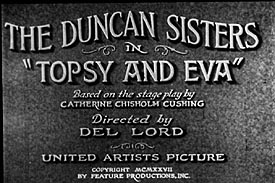
 |
The 21 clips available here give you access to about 15% of the complete movie. The most under-represented elements are the love scenes between the story's nominal heroine and hero (Mariette and George), and the long chase scene in which Legree, Sambo, Quimbo and some dogs pursue Topsy across a snowy landscape. Topsy is not fleeing for freedom, and she is not the "property" that Legree is trying to recapture as the villain of this story. Instead, he trying to recover the will he hid to rob the orphaned (white and aristocratic) Mariette of her inheritance. What plot the movie has, in other words, has nothing in common with Stowe's act of protest. |
| These clips, however, will allow you to get a good idea how the film revises two stories: Stowe's novel and Cushing's play. Some scenes echo incidents in Uncle Tom's Cabin, and there are even moments that clearly want to appeal to its audience on an essentially sentimental basis. Topsy and Eva does not mount the kind of frontal assault on Stowe's story that a parody or burlesque would. But it clearly sees the novel mainly as an occasion for comedy, much of it crude and racist, some of it genuinely inventive and perhaps funny even still. Some scenes are taken fairly directly from the play, but that was essentially a musical. The silent film makes no attempt to reproduce its songs and dance numbers. | |
| There is no question that the film puts Rosetta's impersonation of Topsy at its center. But viewers will have to answer for themselves the question of how simply derogatory that representation is. The film repeatedly treats Topsy's "blackness" as both funny and grotesque, but at the same time, Topsy is the most active and spirited character in this world. Good often comes out of her "wickedness." On the other hand, the film puts almost no critical pressure on slavery. Neither Tom nor Eva die in this version, but neither are any black characters freed nor do any of them seem to want their freedom. | |
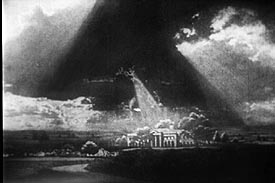
The film begins with the doctor who is summoned to attend Eva's birth, following him from home to carriage house and onto the road in a race to the St. Clare mansion with a very white stork carrying a very white baby. As a ray of sun blesses the house, the birth is recorded by an angel in heaven. This 36 second clip is the end of that sequence, slightly abridged. (click on image at left) |
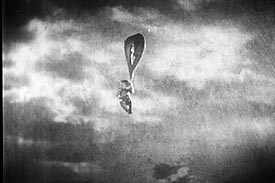
Under much stormier skies, and with no doctor in sight, a very black stork carries a black infant to two cabins, where neither the unmarried female slave nor the male slave with a dozen children already (not shown in clip) wants anything to do with her. The child is dropped into a trash can, but her birth is recorded in the "COLORED DEPT." of heaven. (click on image at left) |
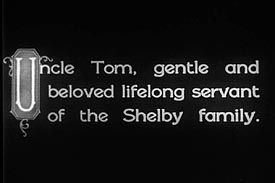 After Eva and Topsy's births, the film jumps directly to the scene Topsy and Eva began with onstage: an auction at which the Shelby slaves are being sold. This clip begins with a shot of Tom with Eliza and an infant, the most sentimental representation of "slavery" in the movie. The focus quickly shifts, however, to the "heroine" and "hero" — Mariette, the "niece and ward of Simon Legree," and George Shelby. (In the play Marietta is Augustine St. Clare's ward.)
After Eva and Topsy's births, the film jumps directly to the scene Topsy and Eva began with onstage: an auction at which the Shelby slaves are being sold. This clip begins with a shot of Tom with Eliza and an infant, the most sentimental representation of "slavery" in the movie. The focus quickly shifts, however, to the "heroine" and "hero" — Mariette, the "niece and ward of Simon Legree," and George Shelby. (In the play Marietta is Augustine St. Clare's ward.)
(click on image at left) |
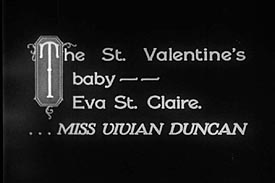
Although Rosetta Duncan is listed first in the opening credits, and is clearly the center of the film's attention, Vivian as Eva is brought into the story through this elaborate placard, which introduces an even more fanciful scene that has no visual connection to anything else in the movie except the heaven where Eva's birth had been recorded by an angel. (click on image at left) |
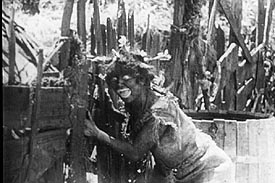 There is no placard to introduce Rosetta as Topsy. The camera discovers her about to rob a chicken coop, which she does while getting covered with feathers. She's on her way to rob a rabbit hutch when she sees the billy goat who frightens her in this clip — though Topsy also then effectively stops Legree in the middle of his cruel whipping of Eliza. Eliza is never seen again, but Topsy will foil Legree several more times.
There is no placard to introduce Rosetta as Topsy. The camera discovers her about to rob a chicken coop, which she does while getting covered with feathers. She's on her way to rob a rabbit hutch when she sees the billy goat who frightens her in this clip — though Topsy also then effectively stops Legree in the middle of his cruel whipping of Eliza. Eliza is never seen again, but Topsy will foil Legree several more times.
(click on image at left) |
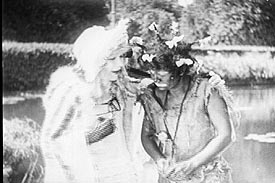
The picture left is from Topsy's first encounter with Eva, whose golden hair is what attracts her first. The clip shows their second scene together, as they become even better friends. Here it is Topsy's body that fascinates Eva. Throughout the film Topsy will be in almost continuous motion — even her face is seldom still — while in many of her scenes Eva lies in a swoon. (click on image at left) |
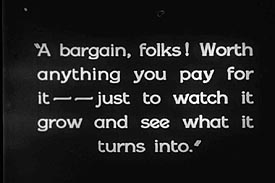
Topsy is the last slave auctioned (Eva winds up purchasing her for 5¢ when no one else offers to take her at all). Just before going up on the block Topsy takes a big bite of Legree's chaw of tobacco, thinking it is a sandwich, which explains her nausea in the clip. The crudity of what happens next may shock even 21st century viewers — the only explanation for it is surely Topsy's "blackness." (click on image at left) |
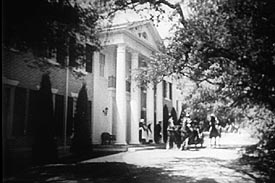 The "Arrival at St. Clare's" was a staple of the Tom Shows for at least 50 years. There is something wonderfully inventive, maybe even subversive, about the way the Duncans stage it. When Ophelia tells Topsy it's time for the first bath she has ever had, she tries to escape by climbing up one of the stately white columns that said "plantation" in the popular mind. The clip abridges the scene, leaving out most of the byplay between Eva and Topsy.
The "Arrival at St. Clare's" was a staple of the Tom Shows for at least 50 years. There is something wonderfully inventive, maybe even subversive, about the way the Duncans stage it. When Ophelia tells Topsy it's time for the first bath she has ever had, she tries to escape by climbing up one of the stately white columns that said "plantation" in the popular mind. The clip abridges the scene, leaving out most of the byplay between Eva and Topsy.(click on image at left) |
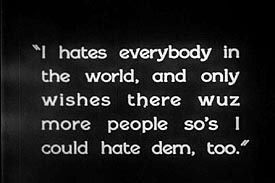 Ophelia puts Topsy into cleaner and more decent clothes (though her hair remains untamed, and her outfits will regress back to minstrel costumes later in the film), but as in Stowe's novel, it's Eva and her "love" that can clean up Topsy's "wickedness." This is one of the scenes where the movie moves closest to Stowe's sentimental narrative. Don't worry, though, Rosetta's Topsy can't be tamed this easily — if at all. . .
Ophelia puts Topsy into cleaner and more decent clothes (though her hair remains untamed, and her outfits will regress back to minstrel costumes later in the film), but as in Stowe's novel, it's Eva and her "love" that can clean up Topsy's "wickedness." This is one of the scenes where the movie moves closest to Stowe's sentimental narrative. Don't worry, though, Rosetta's Topsy can't be tamed this easily — if at all. . .(click on image at left) |
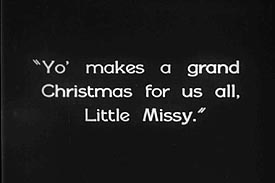 From this point on the story occurs on Christmas day, at the St. Clare mansion, at Simon Legree's house, and in the space between them. There's no indication of where this is, but the deep snow in all the outdoor scenes means we're a long way from Louisiana, or even Kentucky. When Topsy comes down the chimney as Santa Claus, we're also a long way from conventional images of Christmas. (As Ophelia points out, the presents she distributes "are things you've stolen since you came here.")
From this point on the story occurs on Christmas day, at the St. Clare mansion, at Simon Legree's house, and in the space between them. There's no indication of where this is, but the deep snow in all the outdoor scenes means we're a long way from Louisiana, or even Kentucky. When Topsy comes down the chimney as Santa Claus, we're also a long way from conventional images of Christmas. (As Ophelia points out, the presents she distributes "are things you've stolen since you came here.")
(click on image at left) |
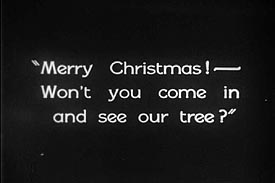 Two sets of stereotypes are on display in this clip and the next — one derived from the traditions of melodrama, the other from the history of slavery. Just before the first clip starts, Legree (after locking Mariette up to prevent the revelation of her father's lost will) goes to St. Clare's to collect the money still owed him for Topsy and Tom. St. Clare is unable to pay, and Legree, sneering in the most approved style, ruins the holiday festivities. But those "festivities" show Tom being treated as a kind of toy.
Two sets of stereotypes are on display in this clip and the next — one derived from the traditions of melodrama, the other from the history of slavery. Just before the first clip starts, Legree (after locking Mariette up to prevent the revelation of her father's lost will) goes to St. Clare's to collect the money still owed him for Topsy and Tom. St. Clare is unable to pay, and Legree, sneering in the most approved style, ruins the holiday festivities. But those "festivities" show Tom being treated as a kind of toy.(click on image at left) |
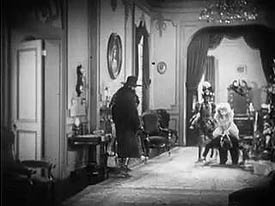 This clip continues the sequence. The most striking thing about it might be the savage way it revises the familiar image of Tom carrying Eva at the end of her life. Or the most striking thing might be the way Topsy kicks him throughout the scene. Or the most striking thing might be the way the film expects viewers to move back and forth without ideological whiplash from the comedy of its ab-use of Tom to the tragedy of Legree's abuse of him.
This clip continues the sequence. The most striking thing about it might be the savage way it revises the familiar image of Tom carrying Eva at the end of her life. Or the most striking thing might be the way Topsy kicks him throughout the scene. Or the most striking thing might be the way the film expects viewers to move back and forth without ideological whiplash from the comedy of its ab-use of Tom to the tragedy of Legree's abuse of him.(click on image at left) |
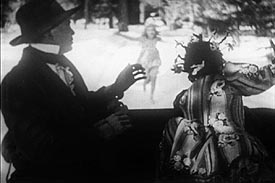 Unable to bear the thought of losing Topsy, Eva chases after Legree's sled until (as she had earlier in the film) she suffers a fit of some kind. In the earlier scene Topsy revives her with her "asafedity bag," but here she can only watch helplessly as she and Tom are carried off. The man who carries the unconscious Eva back to her house is George Shelby. His presence at the St. Clare mansion is never explained.
Unable to bear the thought of losing Topsy, Eva chases after Legree's sled until (as she had earlier in the film) she suffers a fit of some kind. In the earlier scene Topsy revives her with her "asafedity bag," but here she can only watch helplessly as she and Tom are carried off. The man who carries the unconscious Eva back to her house is George Shelby. His presence at the St. Clare mansion is never explained.(click on image at left) |
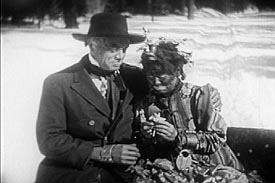 This clip gives a good idea of how disruptive Topsy almost always is. She and Tom are portrayed as heartbroken as Legree carries them to his house, and Topsy sadly starts looking over the few things she has to remember her life with Missy Eva. The last thing she shows Tom is the brouch "Miss Shifless gave me." The clip shows the rest of the scene. (click on image at left) |
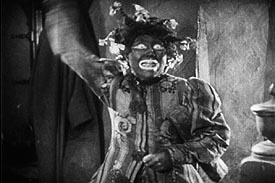 Fearing that without Topsy Eva will die, George hurries to Legree's. There he discovers Mariette's predicament, and to rescue her attacks Legree. Topsy unlocks the door for Mariette, who says to her "Isn't this fight terrible?" Topsy's reply is entirely in character: "Hell, no! It's great!" While the two white men battle each other on the stairs, Topsy takes care of Sambo and Quimbo — as many times as necessary.
Fearing that without Topsy Eva will die, George hurries to Legree's. There he discovers Mariette's predicament, and to rescue her attacks Legree. Topsy unlocks the door for Mariette, who says to her "Isn't this fight terrible?" Topsy's reply is entirely in character: "Hell, no! It's great!" While the two white men battle each other on the stairs, Topsy takes care of Sambo and Quimbo — as many times as necessary.(click on image at left) |
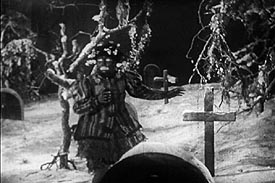 This clip needs setting up. As George and Legree continue to slug it out, Mariette gives the will to Topsy with orders to take it to St. Clare. The chase scene that follows lasts over 10 minutes. Though it begins and ends in daylight, in the middle Topsy tries to hide in a dark graveyard where unknown to her a group have runaway slaves are already hiding, having buried themselves in the snow. What follows gives the film a chance to exploit the popular linkage of African Americans and superstition.
This clip needs setting up. As George and Legree continue to slug it out, Mariette gives the will to Topsy with orders to take it to St. Clare. The chase scene that follows lasts over 10 minutes. Though it begins and ends in daylight, in the middle Topsy tries to hide in a dark graveyard where unknown to her a group have runaway slaves are already hiding, having buried themselves in the snow. What follows gives the film a chance to exploit the popular linkage of African Americans and superstition.
(click on image at left) |
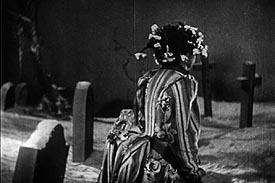 This clip is another excerpt from the graveyard scene. It begins with the owl who terrifies Topsy as much as the quaking graves, and for as long. The scene belabors both gags at a length that must have grown tedious to at least some of its original viewers, no matter how much they enjoyed watching "blacks" express fear. The sequence was shot on a set built for the Duncans at United Studios, which may explain why its visual style is so disconnected from the rest of the movie.
This clip is another excerpt from the graveyard scene. It begins with the owl who terrifies Topsy as much as the quaking graves, and for as long. The scene belabors both gags at a length that must have grown tedious to at least some of its original viewers, no matter how much they enjoyed watching "blacks" express fear. The sequence was shot on a set built for the Duncans at United Studios, which may explain why its visual style is so disconnected from the rest of the movie.(click on image at left) |
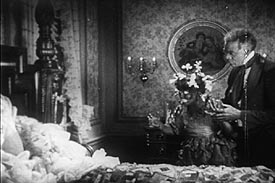 During the chase sequences Topsy also displays a lot of resourcefulness, and in a scene that revises Eliza's famous river crossing leaves Legree drowning in an icy pond. Thus the villain has already been foiled when Topsy finally reaches St. Clare's. Mariette has also been reunited with George and her fortune. The film is ready for its climax, which stays very faithful to Cushing's play script. It dramatically points the contrast between Eva's iconic status as inert white object of adoration and concern, and Topsy's animated body and soul.
During the chase sequences Topsy also displays a lot of resourcefulness, and in a scene that revises Eliza's famous river crossing leaves Legree drowning in an icy pond. Thus the villain has already been foiled when Topsy finally reaches St. Clare's. Mariette has also been reunited with George and her fortune. The film is ready for its climax, which stays very faithful to Cushing's play script. It dramatically points the contrast between Eva's iconic status as inert white object of adoration and concern, and Topsy's animated body and soul.
(click on image at left) |
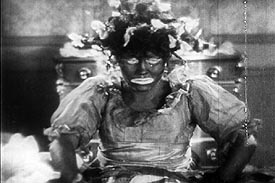 The whole scene of Topsy at Eva's bedside lasts 8 minutes, and is played very "straight" right up to the end. When Topsy realizes she doesn't have her asafedity bag, she turns helplessly to Tom, who tells her "Den pray, Topsy, pray." To save Eva, she does, offering the "Lawd" herself, and promising to stop stealing and swearing. This clip is a segment of that scene (THE PLAYSCRIPT can give you a good idea of the rest of it).
The whole scene of Topsy at Eva's bedside lasts 8 minutes, and is played very "straight" right up to the end. When Topsy realizes she doesn't have her asafedity bag, she turns helplessly to Tom, who tells her "Den pray, Topsy, pray." To save Eva, she does, offering the "Lawd" herself, and promising to stop stealing and swearing. This clip is a segment of that scene (THE PLAYSCRIPT can give you a good idea of the rest of it).(click on image at left) |
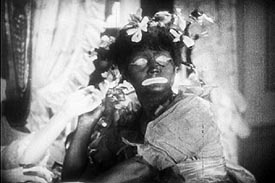 At the end the scene disrupts itself. When Eva recovers, Topsy delightedly calls herself a "miracle worker." When Tom suddenly finds her asafedity bag, however, she quickly reverts to her original character. Though she had just vowed never to "cuss" again, her reaction to Tom's news brings a smile even to his face. Cushing's script ended the scene on a much less impious note — though we can't know how often Rosetta may have already ad libbed the new line in live performances.
At the end the scene disrupts itself. When Eva recovers, Topsy delightedly calls herself a "miracle worker." When Tom suddenly finds her asafedity bag, however, she quickly reverts to her original character. Though she had just vowed never to "cuss" again, her reaction to Tom's news brings a smile even to his face. Cushing's script ended the scene on a much less impious note — though we can't know how often Rosetta may have already ad libbed the new line in live performances.
(click on image at left) |
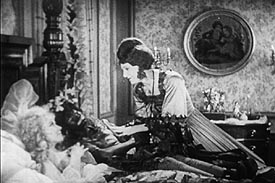 Although Vivian's Eva lives, the film incorporates the effect her death has on Ophelia and Topsy when "Miss Shifless" dries her tears and gives her the handkerchief Topsy has so often stolen. The film's own plot reaches closure in a vignette of Mariette and George kissing. Those moments aren't shown here. Instead, you can see the film's very last scene, in which Ophelia helps Topsy into Eva's bed, and they fall asleep together. There is more animation on Eva's face here than just about anywhere else in the film, though it's not easy to read what her features are supposed to be expressing.
Although Vivian's Eva lives, the film incorporates the effect her death has on Ophelia and Topsy when "Miss Shifless" dries her tears and gives her the handkerchief Topsy has so often stolen. The film's own plot reaches closure in a vignette of Mariette and George kissing. Those moments aren't shown here. Instead, you can see the film's very last scene, in which Ophelia helps Topsy into Eva's bed, and they fall asleep together. There is more animation on Eva's face here than just about anywhere else in the film, though it's not easy to read what her features are supposed to be expressing.(click on image above) |
